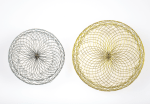Coronary Microvascular Dysfunction (CMD) is being increasingly considered a common consequence of STEMI. Its presence partly explains the persistence of angina symptoms in over 50% of patients after PCI, despite successful epicardial artery reperfusion. Also, CMD has been independently associated with worse left ventricular ejection fraction recovery, which leads to worse prognosis, including recurrent events,...
TAVR vs SAVR in Los Risk Patients: 10-Year Outcomes of the NOTION Trial
Transcatheter aortic valve replacement (TAVR) has revolutionized the treatment of patients with severe aortic stenosis (AS). Randomized studies have shown the benefits of TAVR in patients at prohibitive surgical risk, as well as high and intermediate risk. The NOTION trial (Nordic Aortic Valve Intervention Trial) randomized patients with low risk severe AS to TAVR and...
Third Generation Balloon-Expandable and Self-Expanding Valves: TAVR Meta- Analysis
TAVR’s significant advance has driven the development of valve technology, which is currently in its third generation. Even though outcomes have improved, randomized studies are yet to compared balloon-expandable (BEV) vs self-expanding (SEV) valves in randomized studies, and we only have information from different analysis with contradicting conclusions. This was a meta-analysis of 16 studies...
EuroPCR 2024 | Complete revascularization affects clinical outcomes? REVIVED.BCIS2 Insights
Complete revascularization has shown in several studies and meta-analysis a benefit in mortality vs. incomplete revascularization. The REVIVED-BCIS looked at whether there were differences in mortality and hospitalization for cardiac failure in patients with ventricular function deterioration and viability when comparing coronary angioplasty(PCI) against optimal medical treatment. This study showed that PCI was not associated...
EuroPCR 2024 | OBSERVANT II: TAVR in the “Real World”
This study analyzed 2,493 “real world” patients, 1,352 receiving the Evolut R/Pro, 675 the SAPIEN, 3,270 the Acurate Neo and 192 the Portico. Primary end point was all cause mortality and major adverse cardiovascular events (MACE) at 5 years. Populations were similar, with EuroSCORE 4.9%, and there were no significant differences in comorbidities or echocardiographic...
Aortic Stenosis Progression Evolution
Aortic stenosis is an increasingly common valvulopathy because people are living longer now. A present, the main treatment consists of surgical (SAVR) or transcatheter aortic valve replacement. (TAVR). One of the main challenges of this disease is its progression. The European guidelines recommend Doppler echocardiograms every 2 to 3 years for mild cases, mildly calcified,...
Quality of Life in Medium-Risk Patients Treated with TAVR vs SAVR
Transcatheter aortic valve replacement (TAVR) and surgical aortic valve replacement (SAVR) have demonstrated similar outcomes in symptomatic aortic stenosis patients (at high or intermediate risk) in terms of 5-year survival. When evaluating the quality of life (QoL) of these two treatment strategies in patients with high surgical risk, there were no significant differences at 5...
Evolution of Leak in Left Atrial Appendage Closure
Atrial fibrillation is common in elderly people and is associated with a higher risk of ischemic stroke. Left atrial appendage occlusion (LAAO) is a valid strategy, especially in patients at high risk of bleeding. The presence of peridevice leak (PDL) has been linked to stroke, although some analyses, such as the PROTEC-AF Study, suggest that...
TAVR in Bicuspid Valves
Bicuspid aortic valve (BAV) disease affects 1%-2% of the population and manifests with severe aortic stenosis in the middle-aged. It characterizes for a very different anatomy with more calcification than the tricuspid aortic valve. At present, surgical aortic valve replacement (SAVR) is the first treatment indication. TAVR in this scenario has shown, in different studies,...
Reinterventions in TAVR with Self-Expanding Valves
TAVR treatment of severe aortic stenosis is becoming more and more common, showing comparable evolution, or even superior in some studies when using the femoral approach, vs. surgical aortic valve replacement (SAVR). One of the current challenges is TAVR durability vs. SAVR. Even though 9 or 10 years has been deemed acceptable by current standards,...







